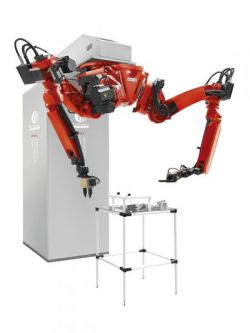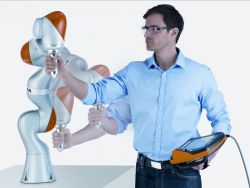Robotic Integration in Small Businesses with SMErobotics

Posted on Jul 22, 2014 in Robotics
4 min read time
Most people think that the robotic industry is only reserved for the automotive world and big production lines. This was true years ago, now with easy programming methods, Adaptive Robot Grippers and flexible robots, it is easier to justify the use of a robot in a small or medium sized enterprise. The SMErobotics collective is developing several methods to allow small enterprises to fit robots into their production line with a fast payback and minimal robotic knowledge. This consortium helps enterprises to get in touch with members from the robotics industry, so that they can work together to better perform assembly tasks, welding tasks and many others.
These days it is harder to find qualified employees with the exact knowledge to perform a certain job. For this reason, you may want to keep them doing the task that needs knowledge and reflexion. Physical operations that needs strength, endurance and precision can then be delegated to robots. In this situation, industrial automation may be the key for success for small to medium enterprises, where the integration of robotics is critical in this type of company. Even though, most of the automation systems presently out there are adapted for big robust industrial applications. This is where SMErobotics gets involved.
Most of the time, using a robot is simpler than it looks. Nowadays, robotics can be adapted to a virtually infinite number of tasks without using complex programming methods. Take a look at the vision of these operators on what their future workshop might look like, it could give you some interesting ideas and maybe you will recognize your company profil.
The SMErobots consortium was established in 2005. It is a collaboration of 5 robot manufacturers, 5 leading research institutes and consultants in the robotic industry. Its companies have experience in different automated fields such as: vision, robotic hardware and software. Having all this knowledge in one place facilitates the task of problem solving. Companies propose their industrial problems, while SMErobotics comes up with a viable solution for the enterprise by using their different partners' expertise. The solution comes with the hardware, training at all levels of the enterprise and a business/financial plan.
SME Robotics Demonstration
The 4 robotics projects showcased are presented as being representative of what SMErobotics can create. As you see a lot of diversity in applications is used, as well as a huge diversity of equipment.
Assembly With Dual Arm Industrial Manipulators
Assembly tasks that would require specific fixtures can now be handled by a flexible dual-arm setup. Using CAD models and the feedback of the workers, who are using manual guidance, touch screens and 3D sensing, gives the robotic cell all the tools necessary to execute a precise job. Using all these tools, as well as having human feedback, the robot can adapt its work to what's in front of it. The workers still have to supervise the operations of the robotic cell and can react when facing a problem such as part misalignment or dropped components.

Human-Robot Cooperation in Wooden House Production
A large gantry robot assists human workers in handling and machining components for prefabricated wooden houses. Using CAD models, the robot basically picks-and places wooden parts, fixes them together and cuts them when needed. Since these operations often involve great uncertainties, the workers can react by communicating with the robot if something goes wrong or just to re-plan the robot path. Using sensing and safety sensors the robot can adapt to the part it is handling instead of only replicating the CAD data.
Assembly with Sensitive Compliant Robot Arms
This project is basically a demonstrator using human-like motions to program a robotic system. The principle is quite simple. It uses a compliant robot (here a KUKA lightweight robot) and teachs it different assembly tasks. It has the ability to reason about needed information; what is available and what is missing. It will also know how to retrieve missing data, either by its own capability or by its interaction with the user through dialogue. For example, if the system has no information about an object position, it could ask the user to show this position and then the user can manually guide the robot arm to this position.

Welding Robot Assistant
In small welding shops most of the parts do not have equvalent CAD models and there is minimal information available on them. This robotic cell is equipped with a camera that can scan the parts in 3D and recognize individual workpieces and different welding seams. Then the operator can figure out the different sequences needed by the touch up programming or the production sequence can be refined based on the operator’s feedback.
All SMErobotics projects have 4 main goals. Every single project has to fulfill these goals to be suitable for a small to medium enterprise.
1. Lean equipment for rapid changeover (by the worker): All changeover and setup uncertainties have to be manageable, even when using low-cost devices that have not passed a certification procedure for compatibility.
2. Robust production through embedded cognitive competences: All operation uncertainties have to be manageable, including situations in which application-level errors occur.
3. Continual process adaptation and task learning: The desire for continuous process optimization gives rise to the objective of continual, (semi-)automatic system adaptation. The same applies to learning, which can be iterative, structural or interactive, to automate seamless integration of new tools or requirements.
4. TCO-effectiveness under uncertain conditions: Their combined technical and economic objective is to increase the life-cycle effectiveness for the owner of the robotic system, and to support the SME by providing tools for estimating the production costs and the return on any further investment.
These applications are quite innovative and may suit your workshop. Applications such as programming by demonstration can be done with tools such as Kinetiq Teaching and can save a lot of time in programming welding trajectories for your small to medium enterprise.








Leave a comment